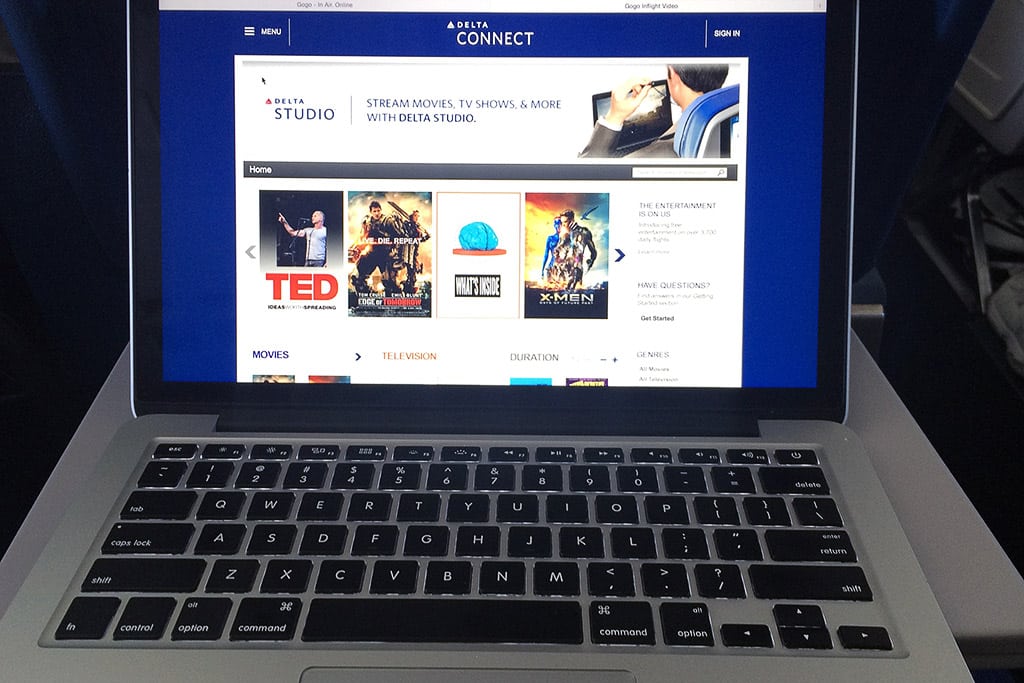Skift Take
As the WiFi feud rages on the service is bound to get better and better. Connected and entertained, passengers win every time.
As the in-flight Wi-Fi race continues, times are good for multiple-device toting, text slinging, email rustling, always-on passengers.
With airlines and suppliers making progress month-to-month, a feud has taken over the skies, and it’s bound to get hotter, faster, better, and far more entertaining.
The Reds
Virgin America has announced a fleet-wide rollout of Gogo’s ATG-4 Wi-Fi service, to be completed this week when its Airbus A319 “Jane” gets equipped.
ATG-4 Wi-Fi offers peak speeds of 9.8 Mbps to each aircraft. That’s more than triple the peak speed of the 3.1 Mbps available on first-generation inflight Wi-Fi, according to Virgin America and Gogo.
“Our goal is to continue to innovate and stay ahead of the competition,” says Mark Bianchi, Senior Vice President of Technical Operations at Virgin America. “This upgrade is the latest in a series of investments aimed at keeping our tech-forward travelers more connected, productive and entertained at 35,000 feet.”
Dave Bijur, Gogo’s regional president, says: “ATG-4 has had a significant impact on the market and we continue to see positive results from this newer technology.”
The Blues
At the same time, ViaSat, the satellite provider for Thales’ LiveTV, which powers JetBlue’s Fly-Fi, celebrates the one year anniversary of the launch of its Exede Internet. The company confirmed its commitment to make in-flight Wi-Fi fast and affordable (even free) for everyone. Fulfillment of that dream, explains Don Buchman, ViaSat VP of Exede Mobility, is a “function of balancing service with the right economics.”
“Airlines want to delight their customers,” says Buchman, “and the customers themselves don’t want to pay extra fees, especially for sub-par service. Nearly every airline today is evaluating the right approach to deliver services like Exede in the Air in a way that preserves their bottom lines. The good news is that these economic models are now beginning to emerge.”
JetBlue’s Jaime Perry, director, product development speaks to emerging economic models when he says:
“In conjunction with Thales and ViaSat, we concluded that the onboard Wi-Fi experience the other guys were offering was unsatisfactory, so we decided to do something revolutionary – provide our passengers with a fantastic high speed onboard Wi-Fi offering at no charge. We believe that Fly-Fi, powered by Exede Internet, is an important component of our passengers’ positive experience and loyalty to us. The increased take rates we’re seeing allow us to pursue a very different monetization strategy, with Verizon, Time, and The Wall Street Journal signing on as sponsors and helping us to keep the basic Fly-Fi service free.”
The monetization part is important. If airlines can get their Wi-Fi to earn revenue, then free in-flight Wi-Fi becomes far more attractive, affordable and will thus be more readily available.
In this first year, ViaSat indicates, Exede has had over four times the average number of passengers using the service on each flight compared to the nearest competitor, with take rates on flights more than three hours approaching 40%. In hardware terms, 2.5 million personal electronic devices have connected to the service. The company also says data use per passenger has doubled this year, with the system supporting high-demand content. ViaSat indicates that 20% percent of all data used is for streaming applications, a number that is increasing each month, and made possible by 12 Mbps available per passenger.
Buchman says that ViaSat, which also supplies satellite services on some United flights, is the “only broadband offering in the sky that begins to approximate what consumers expect at home or in the office.” Adding: “While other services today parcel out their scarce bandwidth through techniques like charging high fees to discourage use, blocking some applications, or allowing access only to limited ‘walled garden’ content, Exede in the Air has shown what’s possible when you deliver meaningful amounts of bandwidth to passengers, and we have more coming as we deliver our next class of satellites.”
Fighting Words
Gogo points out that its ATG-4 technology “includes three industry-leading innovations: the addition of directional antennas and dual modems on each aircraft and the deployment of EV-DO Rev B technology on Gogo’s airborne and ground networks. Utilizing directional antennas and dual modem technology, ATG-4 increases overall peak connection speeds and ensures a more reliable connection to each and every passenger on board who chooses to connect.”
As Steve Nolan, Gogo’s Director of Communications tells Skift, ATG-4 is only one of a host of Gogo’s options available to airlines, charters, private jets, and everyone else in the skies. The right solution, he explains, is not dependent on the capacity satellite alone, but on a host of other factors, including the areas the satellite covers, the hardware on the aircraft, and the individual needs of the operator. “There are advantages and disadvantages to every single one of [the in-flight Wi-Fi options available today] and speed is not the only factor,” he says.
To put this all in plain terms, connection speed is a nebulous flowy-changy thing. Regardless of the satellite provider, airline, supplier or method of connection, your individual user experience may vary.
So who wins this in-flight Wi-Fi show-down? Virgin America or JetBlue? Gogo’s suite of connectivity options or Thales’ LiveTV powered by ViaSat? Global Eagle Entertainment supplying Southwest? United? American? Delta? Spirit? Well, it’s not Spirit.
The Daily Newsletter
Our daily coverage of the global travel industry. Written by editors and analysts from across Skift’s brands.
Have a confidential tip for Skift? Get in touch
Photo credit: Delta's in-flight offering. Skift
